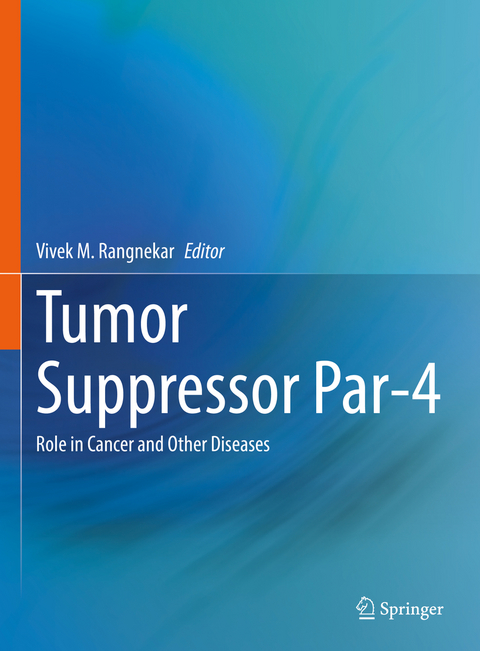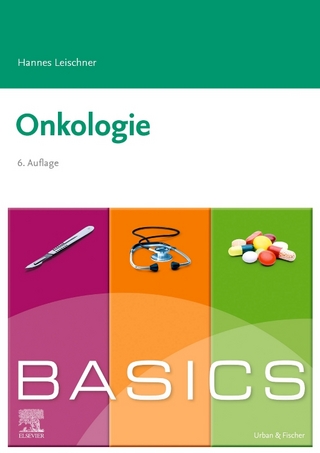
Tumor Suppressor Par-4
Springer International Publishing (Verlag)
978-3-030-80557-9 (ISBN)
This second, companion volume will provide a comprehensive overview of Par-4's role in cancer and other diseases. Chapters are written by leading researchers, and will be useful for a broad audience across the scientific community, particularly students and trainees, who are the next generation of scientists and clinicians to participate in new studies and discoveries on Par-4.
lt;b> Vivek M. Rangnekar, Ph.D. is Professor and Alfred Cohen Chair in Oncology Research in the Department of Radiation Medicine and Associate Director of the Markey Cancer Center at the University of Kentucky. His laboratory studies the molecular cross-talk between oncogenes and tumor suppressor genes in an effort to tilt the balance in favor of tumor suppressor function. Dr. Rangnekar originally identified and discovered the tumor suppressor protein Par-4/PAWR in 1993.
Introduction. --Part 1.- Chapter 1. Role of Par-4 in lung cancer.- Chapter 2. Prostate apoptosis response-4 in nasopharyngeal carcinoma.- Chapter 3. Role of Par-4 in Chemoresistance and targeted therapies in ovarian and endometrial cancers.- Chapter 4. Regulation of Par-4 and role in GI tumors.- Chapter 5. Role of Par-4 in prostate cancer.- Chapter 6. Activation of apoptosis by Par-4 in pancreatic cancer.- Chapter 7. Role of Par-4 and GRP78 in Glioblastoma.- Chapter 8. Role of Par-4 in breast cancer recurrence.- Chapter 9. Involvement of Par-4 in breast cancer.- Chapter 10. Role of endogenous Par-4 in CLL.- Chapter 11. Role of Par-4 in inhibition of TCL1 induced growth.- Chapter 12. Par-4/THAP in survival of T-cell acute lympoblastic leukemia cells.- Chapter 13. Par-4 expression in cholangiocarcinoma.- Chapter 14. Par-4 suppresses breast cancer growth and invasion of breast cancer cells.- Chapter 15. PAWR as direct SRC-1/HOXC11 suppression target.- Chapter 16. Par-4 cleavage is required for TNF induced apoptosis.- Chapter 17. Par-4 secretagogues.- Chapter 18. Recombinant production and characterization of SAC.- Chapter 19. Anti-tumor effects of plant derived Par-4.- Chapter 20. Par-4 in Mycobacterium tuberculosis Infected Macrophages.- Part 2 - Role in other Diseases.- Chapter 21. Role of Par-4 in ceramide inducible effects in neurons.- Chapter 22. Role of Par-4 in Alzheimers disease.- Chapter 23. Dopamine signaling in association with induction of Par-4 protein expression.- Chapter 24. Par-4 (PAWR) in major depressive disorder.- Chapter 25. Par-4 dependent apoptosis of islet beta cells in type 2 diabetes.- Chapter 26. Par-4 in cardiac fibroblast senescence.- Chapter 27. Par-4 in ocular development and disease.- Chapter 28. Par-4 in apoptosis during human salivary gland development.- Chapter 29. Suppression of Par-4 protects human renal proximal tubule cells from apoptosis.- Chapter 30. Lessons from knockout mice.- Part 3 - From Bench to Bedside.- Chapter 31. Par-4 secretagogues in clinical trials.- Chapter 32. Potential of Par-4 as a therapeutic target for cancer.
| Erscheinungsdatum | 22.12.2021 |
|---|---|
| Zusatzinfo | X, 331 p. 121 illus., 93 illus. in color. |
| Verlagsort | Cham |
| Sprache | englisch |
| Maße | 210 x 279 mm |
| Gewicht | 1077 g |
| Themenwelt | Medizin / Pharmazie ► Medizinische Fachgebiete ► Onkologie |
| Medizin / Pharmazie ► Studium | |
| Schlagworte | Breast Cancer • cardiac fibroblast senescence • CLL • dopamine signaling • Endometrial Cancer • GI tumors • glioblastoma • Lung Cancer • Major depression • nasopharyngeal carcinoma • ocular development • ovarian cancer • Pancreatic cancer • Prostate Cancer • Protein Expression • SAC • TCL1 • THAP • TNF • type 2 diabetes |
| ISBN-10 | 3-030-80557-3 / 3030805573 |
| ISBN-13 | 978-3-030-80557-9 / 9783030805579 |
| Zustand | Neuware |
| Haben Sie eine Frage zum Produkt? |
aus dem Bereich


